|
THE PROMISED LAND
The capture and removal of Marduk from Babylon had geopolitical
repercussions, shifting for several centuries the center of gravity
from Mesopotamia westward, to the lands along the Mediterranean Sea.
In religious terms, it was the equal of a tectonic earthquake: in
one blow, all the great expectations by Marduk for all gods to be
gathered under his aegis, and all the messianic expectations by his
followers, were gone like a puff of smoke.
But both geopolitically and religiously, the greatest impact can be
summed up as the story of three mountains—the three space-related
sites that put the Promised Land in the midst of it all: Mount
Sinai, Mount Moriah, and Mount Lebanon.
Of all the events that followed the unprecedented occurrence in
Babylon, the central and most lasting one was the Israelite Exodus
from Egypt—when, for the first time, sites that until then were the
gods’ alone were entrusted to people.
When the Hittites who took Marduk captive withdrew from Babylon,
they left behind political disarray and a religious enigma:
-
How
could that happen?
-
Why did it happen?
-
When bad things happened to
people, they would say that the gods were angry; so what now that
bad things happened to gods— to Marduk?
-
Was there a God supreme to
the supreme god?
In Babylon itself, the eventual release and return of Marduk did not
provide an answer; in fact, it increased the mystery, for the
“Kassites” who welcomed the captured god back to Babylon were
non-Babylonian strangers. They called Babylon “Karduniash” and had
names such as Barnaburiash and Karaindash, but little else is known
about them or their original language. To this day it is not clear
from where they came and why their kings were allowed to replace the
Hammurabi dynasty circa 1660 b.c.e. and to dominate Babylon from
1560
b.c.e. until 1160 b.c.e.
Modern scholars speak of the period that followed Marduk’s
humiliation as a “dark age” in Babylonian history, not only because
of the disarray it caused but mainly because of the paucity of
written Babylonian records from that time.
The Kassites quickly
integrated themselves into the Sumerian-Akkadian culture, including
language and cuneiform script, but were neither the meticulous
record-keepers the Sumerians had been nor the likes of previous
Babylonian writers of royal annals. Indeed, most of the few royal
records of Kassite kings have been found not in Babylon but in
Egypt—clay tablets in the El-Amarna archive of royal correspondence.
Remarkably, in those tablets the Kassite kings called the Egyptian
Pharaohs “my brother.”
The expression, though figurative, was not unjustified, for Egypt
shared with Babylon the veneration of Ra-Marduk and, like Babylonia,
had also undergone a “dark age”—a period scholars call the Second
Intermediate Period. It began with the demise of the Middle Kingdom
circa 1780 b.c.e. and lasted until about 1560 b.c.e. As in
Babylonia, it featured a reign of foreigner kings known as “Hyksos.”
Here, too, it is not certain who they were, from where they came, or
how it was that their dynasties were able to rule Egypt for more
than two centuries.
That the dates of this Second Intermediate Period (with its many
obscure aspects) parallel the dates of Babylon’s slide from the peak
of Hammurabi’s victories (1760 b.c.e.) to the capture and resumption
of Marduk’s worship in Babylon (circa 1560 b.c.e.) is probably
neither accident nor coincidence: those similar developments at
parallel times in Marduk’s principal lands happened because Marduk
was “hoist by his own petard”—the very justification for his claim
to supremacy was now causing his undoing.
The “petard” was Marduk’s own initial contention that the time for
his supremacy on Earth had arrived because in the heavens the Age of
the Ram, his age, had arrived. But as the zodiacal clock kept
ticking, the Age of the Ram started to slowly slip away. The
physical evidence from those perplexing times still exists, and can
be seen, in Thebes, the ancient Egyptian capital of Upper Egypt.
Apart from the great pyramids of Giza, ancient Egypt’s most
impressive and majestic monuments are the colossal temples of Karnak
and Luxor in southern (Upper) Egypt.
The Greeks called the place Thebai, from which its name in English—Thebes—derives; the ancient
Egyptians called it the City of Amon, for it was to this unseen god
that those temples were dedicated. The hieroglyphic writing and the
pictorial depictions on their walls, obelisks, pylons, and columns
(Fig. 62) glorify the god and praise the Pharaohs who built,
enlarged, expanded—and kept changing—the temples.
It was there that
the arrival of the Age of the Ram was announced by the rows of
ram-headed sphinxes (see Fig. 39); and it is there that the very
layout of the temples reveals the secret quandary of Egypt’s
followers of Ra-Amon/Marduk.
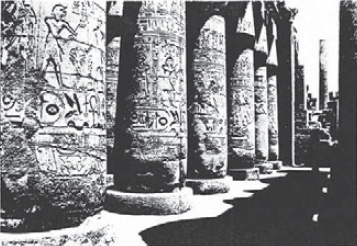
Figure 62
One time, visiting the sites with a group of fans, I stood in the
midst of a temple waving my hands as a traffic policeman; amazed
onlookers wondered, “Who is this nut?,” but I was trying to point
out to my group the fact that the Thebes temples, built by a
succession of Pharaohs, kept changing their orientation (Fig. 63).
It was Sir Norman Lockyer who, in the 1890s, first grasped the
significance of this architectural aspect, giving rise to a
discipline called Archaeo-astronomy.
Temples that were oriented to the equinoxes, like Solomon’s temple
in Jerusalem, (Fig. 64) (and the old St. Peter’s basilica at the
Vatican in Rome), faced permanently east, welcoming sunrise on
equinox day year after year without reorientation.
But temples
oriented to the solstices, like Egypt’s temples in Thebes or China’s
Temple of Heaven in Beijing, needed periodic reorientation because
due to Precession, where the Sun rises on solstice day shifts ever
so lightly over the centuries—as can be illustrated by Stonehenge,
where Lockyer applied his findings (see Fig. 6).
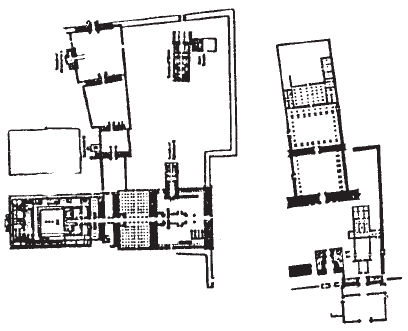
Figure 63
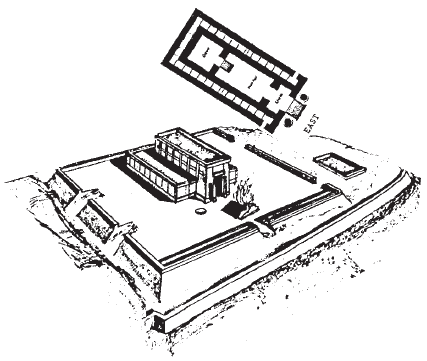
Figure 64
The
very temples that Ra/Marduk’s followers had erected to glorify him
were showing that the heavens were uncertain about the durability of
the god and his Age.
Marduk himself—so aware of the zodiacal clock when he had claimed in
the previous millennium that his time had arrived—tried to shift the
religious focus by introducing the Star Religion of “Marduk is
Nibiru.” But his capture and humiliation now raised questions
regarding this unseen celestial god. The question, Until when will
the Age of Marduk last? changed to the question: If celestially Marduk is the unseen Nibiru, when will it reveal itself, reappear,
return?
As unfolding events showed, both the religious and the geopolitical
focus shifted in the middle of the second millennium b.c.e. to the
stretch of land that the Bible called Canaan.
As the return of
Nibiru started to emerge as the religious focus, the space-related
sites also emerged into sharper focus, and it was in the geographic
“Canaan” where both the Landing Place and the erstwhile Mission
Control Center were located.
Historians tell the ensuing events in terms of the rise and fall of
nation-states and the clash of empires. It was circa 1460 b.c.e.
that the forgotten kingdoms of Elam and Anshan (later known as
Persia, east and southeast of Babylonia) joined to form a new and
powerful state, with Susa (the biblical Shushan) as the national
capital and Ninurta, the national god, as Shar Ilani—“Lord of the
gods”; that newly assertive nation-state was to play a decisive role
in ending Babylon’s and Marduk’s supremacy.
It was probably no coincidence that at about the same time, a new
powerful state arose in the Euphrates region where Mari had once
dominated. There the biblical Horites (scholars call them Hurrians)
formed a powerful state named Mitanni—“The Weapon of Anu”—which
captured the lands that are now Syria and Lebanon and posed a
geopolitical and religious challenge to Egypt.
That challenge was
countered, most ferociously, by Egypt’s Pharaoh Tothmosis III, whom
historians describe as an “Egyptian Napoleon.”
Intertwined with all that was the Israelite exodus from Egypt, that
period’s seminal event, if for no other reason than due to its
lasting effects, to this day, on Mankind’s religions, social and
moral codes, and the centrality of Jerusalem. Its timing was not
accidental, for all those developments related to the issue of who
shall control the space-related sites when Nibiru’s return will
occur.
As was shown in previous chapters, Abraham did not just happen to
become a Hebrew Patriarch, but was a chosen participant in major
international affairs; and the places where his tale took us—Ur,
Harran, Egypt, Canaan, Jerusalem, the Sinai, Sodom and Gomorrah—were
principal sites of the universal story of gods and men in earlier
times.
The Israelite Exodus from Egypt, recalled and celebrated by
the Jewish people during the Passover holiday, was likewise an
integral aspect of the events that were then unfolding throughout
the ancient lands. The Bible itself, far from treating the Exodus as
just an “Israelite” story, clearly placed it in the context of
Egyptian history and the international events of the time.
The Hebrew Bible opens the story of the Israelite exodus from Egypt
in its second book, Exodus, by reminding the reader that the
Israelite presence in Egypt began when Jacob (who was renamed Israel
by an angel) and his other eleven sons joined Jacob’s son Joseph in
Egypt, in 1833 b.c.e. The full story of how Joseph, separated from
his family, rose from being a slave to the rank of viceroy, and how
he saved Egypt from a devastating famine, is told by the Bible in
the last chapters of Genesis; and my take on how Joseph saved Egypt
and what evidence of that exists to this day is told in The Earth
Chronicles Expeditions.
Having reminded the reader of how and when the Israelite presence in
Egypt began, the Bible makes it clear that all that was gone and
forgotten by the time of the Exodus:
“Joseph and all his brothers
and all that generation had passed away.”
Not only they but even the
dynasty of the Egyptian kings who were connected to those times were
also long gone. A new dynasty came into power:
“And there arose a
new king over Egypt who knew not Joseph.”
Accurately, the Bible describes the change of government in Egypt.
The dynasties of the Middle Kingdom based in Memphis were gone, and
after the disarray of the Second Intermediate Period the princes of
Thebes launched the dynasties of the New Kingdom. Indeed, there
arose entirely new kings over Egypt—new dynasties in a new capital,
“and they knew not Joseph.”
Forgetting the Israelite contribution to Egypt’s survival, a new
Pharaoh now saw danger in their presence. He ordered a series of
oppressive steps against them, including the killing of all male
babies.
These were his reasons:
And he said unto his people: “Behold, a nation, Children of Israel,
is greater and mightier than us; Let us deal wisely with them, lest
they multiply
and, when war shall be called, they will join our enemies, and fight
against us, and leave the land.”
Exodus 1:9–10
Biblical scholars have assumed all along that the feared nation of
the “Children of Israel” were the Israelites sojourning in Egypt.
But this is in accord with neither the numbers given nor with the
literal wording in the Bible.
Exodus begins with a list of the names
of Jacob and his children who had come, with their children, to join
Joseph in Egypt, and states that “all of those who descended from
the loins of Jacob, excluding Joseph who was already in Egypt,
numbered seventy.” (That together with Jacob and Joseph the number
totaled 72 is an intriguing detail to ponder.)
The “sojourn” lasted
four centuries, and according to the Bible the number of all the
Israelites leaving Egypt was 600,000; no Pharaoh would consider such
a group “greater and mightier than us.” (For the identity of that
Pharaoh and of “the Pharaoh’s Daughter” who raised Moses as her son,
see Divine Encounters.)
The narrative’s wording records the Pharaoh’s fear that at time of
war, the Israelites will “join our enemies, and fight against us,
and leave the land.” It is a fear not of a “Fifth Column” inside
Egypt, but of Egypt’s indigent “Children of Israel” leaving to
reinforce an enemy nation to whom they are related—all of them
being, in Egyptian eyes, “Children of Israel.”
But what other nation
of “Children of Israel” and what war was the Egyptian king talking
about?
Thanks to archaeological discoveries of royal records from both
sides of those ancient conflicts and the synchronization of their
contents, we now know that the New Kingdom Pharaohs were engaged in
prolonged warfare against Mitanni.
Starting circa 1560 b.c.e. with
the Pharaoh Ahmosis, continued by the Pharaohs Amenophis I,
Thothmosis I, and Thothmosis II, and intensifying under Thothmosis
III through 1460 b.c.e., Egyptian armies thrust into Canaan and
advanced northward against Mitanni. The Egyptian chronicles of those
battles frequently mention Naharin as the ultimate target—the Khabur
River area, which the Bible called Aram-Naharayim (“The Western Land
of the Two Rivers”); its principal urban center was Harran!
It was there, Bible students will recall, that Abraham’s brother
Nahor stayed on when Abraham proceeded to Canaan; it was from there
that Rebecca, the bride of Abraham’s son Isaac, came—she was in fact
the granddaughter of Nahor. And it was to Harran that Isaac’s son
Jacob (renamed Israel) went to find a bride—ending up marrying his
cousins, the two daughters (Le’ah and Rachel) of Laban, the brother
of his mother Rebecca.
These direct family ties between the “Children of Israel” (i.e., of
Jacob) who were in Egypt and those who stayed on in
Naharin-Naharayim are highlighted in the very first verses in
Exodus: the list of the sons of Jacob who had come to Egypt with him
includes the youngest, Ben-Yamin (Benjamin), the only full brother
of Joseph because both were Jacob’s sons by Rachel (the others were
sons of Jacob by his wife Le’ah and two concubines).
We now know
from Mitannian tablets that the most important tribe in the Khabur
River area were called Ben-Yamins! The name of Joseph’s full brother
was thus a Mitannian tribal name; no wonder, then, that the
Egyptians considered the “Children of Israel” in Egypt and the
“Children of Israel” in Mitanni as one combined nation “greater and
mightier than us.”
That was the war the Egyptians were preoccupied with and that was
the reason for the Egyptian military concern— not the small number
of Israelites in Egypt if they stayed, but a threat if they “left
the land” and occupied territory to the north of Egypt.
Indeed,
preventing the Israelites from leaving appears to have been the
central theme of the developing drama of the Exodus—there were the
repeated appeals by Moses to the reigning Pharaoh to “let my people
go,” and the Pharaoh’s repeated refusals to grant that request—in
spite of ten consecutive divine punishments.
Why? For a plausible
answer we need to insert the space connection into the unfolding
drama.
In their northward thrusts, the Egyptians marched through the Sinai
peninsula via the Way of the Sea, a route (later called by the
Romans Via Maris) that afforded passage through the gods’ Fourth
Region along the Mediterranean coast, without actually entering the
peninsula proper. Then, advancing north through Canaan, the
Egyptians repeatedly reached the Cedar Mountains of Lebanon and
fought battles at Kadesh, “The Sacred Place.”
Those were battles, we
suggest, for control of the two sacred space-related sites—the
erstwhile Mission Control Center ( Jerusalem) in Canaan and the
Landing Place in Lebanon. The Pharaoh Thothmosis III, for example,
in his war annals, referred to Jerusalem (“Ia-ur-sa”), which he
garrisoned as the “place reaching to the outer ends of the Earth”—a
“Navel of the Earth.”
Describing his campaigns farther north, he
recorded battles at Kadesh and Naharin and spoke of taking the Cedar
Mountains, the “Mountains of god’s land” that “support the pillars
to heaven.” The terminology unmistakably identifies by their
space-related attributes the two sites he was claiming to have
captured “for the great god, my father Ra/Amon.”
And the purpose of the Exodus?
In the words of
the biblical God
himself,
-
to keep His sworn promise to Abraham, Isaac, and Jacob to
grant to their descendants as “an Everlasting Heritage”
(Exodus 6:
4–8)
-
“from the Brook of Egypt to the River Euphrates, the great
river”
-
“the whole of the Land of Canaan,”
(Genesis 15:18, 17:8)
-
“the Western Mount... the Land of Canaan and Lebanon”
(Deuteronomy
1: 7)
-
“from the desert to Lebanon, from the River Euphrates unto
the Western Sea”
(Deuteronomy 11:24)
-
even the “fortified places
reaching heavenwards” wherein “descendants of the Anakim”—the
Anunnaki—still resided
(Deuteronomy
9: 1–2)
The promise to Abraham was renewed at the Israelites’ first stop, at
Har Ha-Elohim, the “Mount of the Elohim/ gods.”
And the mission was
to take hold, possess, the two other space-related sites, which the
Bible repeatedly connected (as in Psalms 48:3), calling,
-
Mount Zion
in Jerusalem Har Kodshi, “My Sacred Mount”
-
and the other, on the
crest of Lebanon, Har Zaphon, “The Secret North Mount”
The Promised Land clearly embraced both space-related sites; its
division among the twelve tribes granted the area of Jerusalem to
the tribes of Benjamin and Judah, and the territory that is now
Lebanon to the tribe of Asher. In his parting words to the tribes
before he died, Moses reminded the tribe of Asher that the northern
space-related site was in their land—like no other tribe, he said,
they will see the “Rider of the clouds soaring heavenwards”
(Deuteronomy 33: 26).
Apart from the territorial assignment, the
words of Moses imply that the site would be functional and used for
soaring heavenward in the future.
Clearly and most emphatically, the Children of Israel were to be the
custodians of the two remaining space-related sites of the Anunnaki.
That Covenant with the people chosen for the task was renewed, at
the greatest theophany on record, at Mount Sinai.
It was certainly not by chance that the theophany occurred there.
From the very beginning of the Exodus tale— when God called out to
Moses and gave him the Exodus assignment—that place in the Sinai
peninsula occupied center stage. We read in Exodus 3:1 that it
happened at the “Mount of the Elohim”—the mountain associated with
the Anunnaki.
The route of the Exodus (Fig. 65) was divinely
determined, the Israelite multitude having been shown the way by a
“pillar of cloud by day and a pillar of fire by night.”
The Children
of Israel “journeyed in the wilderness of Sinai according to the
instructions of
Yahweh,” the Bible clearly states; in the third
month of the journey they “reached and encamped opposite the Mount”;
and on the third day thereafter, Yahweh in his Kabod “came down upon
Mount Sinai in full view of all the people.”
It was the same mount that Gilgamesh, arriving at the place where
the rocket ships ascended and descended, had called “Mount Mashu.”
It was the same mount with “the double doors to heaven” to which
Egyptian Pharaohs went in their Afterlife Journey to join the gods
on the “planet of millions of years.”
It was the Mount astride the
erstwhile Spaceport—and it was there that the Covenant was renewed
with the people chosen to be the guardians of the two remaining space-related sites.
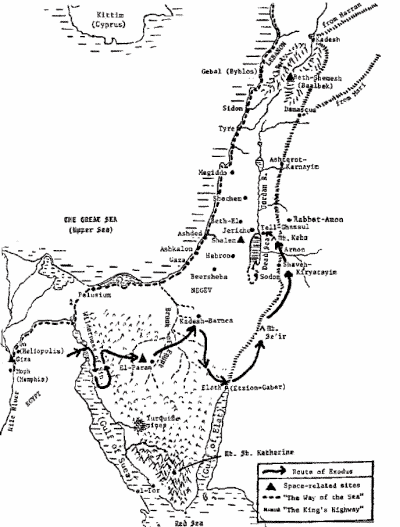
Figure 65
As the Israelites were preparing, after the death of Moses, to
cross the Jordan River, the boundaries of the Promised Land were
restated to the new leader, Joshua. Embracing the locations of the
space-related sites, the boundaries emphatically included Lebanon.
Speaking to Joshua, the biblical God said:
Now arise and cross this Jordan,
thou and all this people, the Children of Israel,
unto the land which I do give to them.
Every place where the soles of your feet shall
tread upon
have I given to you, just as I have spoken to Moses:
From the Desert to the Lebanon,
and from the great river, the River Euphrates,
in the country of the Hittites,
unto the Great Sea, where the sun sets—
That shall be your boundary.
Joshua 1: 2–4
With so much of the current political, military, and religious
turmoil taking place in the Lands of the Bible, and with the Bible
itself serving as a key to the past and to the future, one must
point out a caveat inserted by the biblical God in regard to the
Promised Land.
The boundaries, running from the Wilderness in the
south to the Lebanon range in the north, and from the Euphrates in
the east to the Mediterranean Sea in the west, were reconfirmed to
Joshua. These, God said, were the promised boundaries. But to become
an actual land grant, it had to be obtained by possession. Akin to
the “planting of the flag” by explorers in the recent past, the
Israelites could possess and keep land where they actually set
foot—“tread with the soles of their feet”; therefore, God commanded
the Israelites not to tarry and delay, but to cross the Jordan and
fearlessly and systematically settle the Promised Land.
But when the twelve tribes under the leadership of Joshua were done
with the conquest and settlement of Canaan, only part of the areas
east of the Jordan were occupied; nor were all of the lands west of
the Jordan captured and settled. As far as the two space-related
sites were concerned, their stories are totally different:
Jerusalem—which was specifically listed (Joshua 12: 10, 18: 28)—was
firmly in the hands of the tribe of Benjamin.
But whether the
northward advance attained the Landing Place in Lebanon is in doubt.
Subsequent biblical references to the site called it the “Crest of Zaphon” (the “secret north place”)—what the area’s dwellers, the
Canaanite-Phoenicians, also called it. (Canaanite epics deemed it to
be a sacred place of the god Adad, Enlil’s youngest son.)
The crossing of the Jordan River—an accomplishment attained with the
help of several miracles—took place “opposite Jericho,” and the
fortified city of Jericho (west of the Jordan) was the Israelites’
first target. The story of the tumbling of its walls and its capture
includes a biblical reference to
Sumer (Shin’ar in Hebrew): in spite
of the commandment to take no booty, one of the Israelites could not
resist the temptation to “keep a valued garment of Shin’ar.”
The capture of Jericho, and the town of Ai south of it, opened the
way to the Israelites’ most important and immediate target:
Jerusalem, where the Mission Control platform had been. The missions
of Abraham and his descendants and God’s covenants with them never
lost sight of that site’s centrality. As God told Moses, it is in
Jerusalem that His earthly abode was to be; now the promise-prophecy
could be fulfilled.
The capture of the cities on the way to Jerusalem, along with the
hill towns surrounding it, turned out to be a formidable challenge,
primarily because some of them, and especially Hebron, were
inhabited by “children of the Anakim”—descendants of the Anunnaki.
Jerusalem, it will be recalled, ceased to function as
Mission
Control Center when the spaceport in the Sinai was wiped out more
than six centuries earlier. But according to the Bible, the
descendants of the Anunnaki who had been stationed there were still
residing in that part of Canaan.
And it was “Adoni-Zedek, king of
Jerusalem” who formed an alliance with four other city-kings to
block the Israelite advance.
The battle that ensued, at Gibe’on in the Valley of Ayalon just
north of Jerusalem, took place on a unique day—the day the Earth
stood still. For the better part of that day, “the Sun stopped and
the Moon stood still” (Joshua 10: 10– 14), enabling the Israelites
to win that crucial battle. (A parallel but reverse occurrence, when
nighttime lasted an extra twenty hours, took place on the other side
of the world, in the Americas; we discuss the matter in
The Lost
Realms.)
In the biblical view, then, God himself assured that Jerusalem would
come into Israelite hands.
No sooner was kingship established under David than he was commanded
by God to clear the platform atop Mount Moriah and sanctify it for
Yahweh’s Temple. And ever since Solomon built that Temple there,
Jerusalem/Mount Moriah/ the Temple Mount have remained uniquely
sacred. There is, indeed, no other explanation why Jerusalem—a city
not at major crossroads, far from waterways, with no natural
resources—has been coveted and sacred since antiquity, deemed to be
a singular city, a “Navel of the Earth.”
The comprehensive list of captured cities given in Joshua Chapter 12
names Jerusalem as the third city, following Jericho and Ai, as
firmly in Israelite hands. The story was different, however, in
regard to the northern space-related site.
The Cedar Mountains of Lebanon run in two ranges, the Lebanon on the
west and the anti-Lebanon on the east, separated by the Bekka—the
“Cleft,” a canyon-like valley that has been known since Canaanite
times as the “Lord’s Cleft” or Ba’al-Bekka—hence
Ba’albek, the
current name of the site of the Landing Place (on the edge of the
eastern range, facing the valley).
The kings of the “Mount of the
North” are listed in the Book of Joshua as having been defeated; a
place called Ba’al Gad “in the valley of Lebanon” is listed as
captured; but whether Ba’al-Gad “in the valley of Lebanon” is just
another name for Ba’al-Bekka is uncertain. We are told (Judges 1:
33) that the Tribe of Naphtali “did not disinherit the dwellers of
Beth-Shemesh” (“Abode of Shamash,” the Sun god), and that could be a
reference to the site, for the later Greeks called the place
Heliopolis, “City of the Sun.” (Though later the territories under
Kings David and Solomon extended to include Beth-Shemesh, it was
only temporarily so.)
The primary failure to establish Israelite hegemony over the
northern space-related site made it “available” to others. A century
and a half after the Exodus the Egyptians attempted to take
possession of that “available” Landing Place, but were met by an
opposing Hittite army.
The epic battle is described in words and
illustrations (Fig. 66) on the
walls of Karnak’s temples.
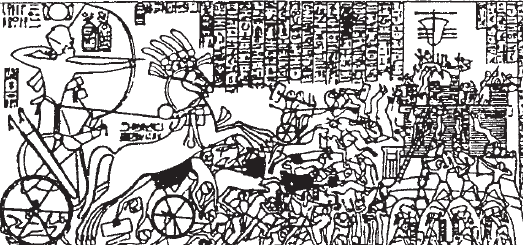
Figure 66
Known as the Battle of Kadesh, it ended
with an Egyptian defeat, but the war and the battle exhausted both
sides so much that the site the Landing Place was left in the hands
of the local Phoenician kings of Tyre, Sidon, and Byblos (the
biblical Gebal). (The prophets Ezekiel and Amos, who called it “the
place of the gods” as well as “the Eden Abode,” recognized it as
belonging to the Phoenicians.)
The Phoenician kings of the first millennium b.c.e. were well aware
of the site’s significance and purpose—witness its depiction on a
Phoenician coin from Byblos (see Fig. 55).
The Prophet Ezekiel (28:
2, 14) admonished the king of Tyre for haughtily believing that,
having been to that sacred site of the Elohim, he had become himself
a god:
Thou hast been to a sacred mount,
As a god werest thou, moving within the fiery
stones . . .
And you became haughty, saying:
“A god am I, at the place of the Elohim I was”;
But you are just Man, not god.
It was at that time that the Prophet Ezekiel—in exile in the “old
country,” near Harran on the Khabur River—saw divine visions and a
celestial chariot, a “Flying Saucer,” but that tale must be
postponed to a later chapter. Here it is important
to note that of the two space-related sites, only Jerusalem was
retained by the followers of Yahweh.
The first five books of the Hebrew Bible, known as the Torah (“The
Teachings”), cover the story from Creation, Adam, and Noah to the
Patriarchs and Joseph in Genesis. The other four books—Exodus,
Leviticus, Numbers, and Deuteronomy—tell the story of the Exodus on
the one hand, and on the other hand enumerate the rules and
regulations of the new religion of Yahweh.
That a new religion
encompassing a new, a “priestly” way of life was promulgated is
explicitly made clear:
“You shall neither do what is done in the
land of Egypt, where you had dwelt, nor as is wont in the Land of
Canaan whence I am bringing you; you shall neither behave like them
nor follow their statutes”
(Leviticus 18: 2–3)
Having established the basics of the faith (“You shall have no other
God before me”) and its moral and ethical code in just Ten
Commandments, there follow page after page of detailed dietary
requirements, rules for priestly rites and vestments, medical
teachings, agricultural directives, architectural instructions,
family and sexual conduct regulations, property and criminal laws,
and so on.
They reveal extraordinary knowledge in virtually every
scientific discipline, expertise in metals and textiles,
acquaintance with legal systems and societal issues, familiarity
with the lands, history, customs, and gods of other nations—and
certain numerological preferences.
The theme of twelve—as in the twelve tribes of Israel or in the
twelve-month year—is obvious.
Obvious, too, is the predilection for
seven, most prominently in the realm of festivals and rituals, and
in establishing a week of seven days and consecrating the seventh
day as the Sabbath. Forty is a special number, as in the forty days
and forty nights that Moses spent upon Mount Sinai, or the forty
years decreed for the Israelite wandering in the Sinai wilderness.
These are numbers familiar to us from the Sumerian tales—the twelve
of the solar system and the twelve-month calendar of Nippur; the
seven as the planetary number of the Earth (when the Anunnaki
counted from the outside in) and of Enlil as Earth’s Commander; the
forty as Ea/Enki’s numerical rank.
The number fifty is also present. Fifty, as the reader knows, was a
number with “sensitive” aspects—it was the original rank number of
Enlil and the stand-in rank of his heir apparent, Ninurta; and more
significantly, in the days of the Exodus, it connoted symbolism to
Marduk and his Fifty Names. Extra attention is therefore called for
when we find that “fifty” was granted extraordinary importance—it
was used to create a new Unit of Time, the fifty-year Jubilee.
While the calendar of Nippur was clearly adopted as the calendar by
which the festivals and other Israelite religious rites were to be
observed, special regulations were dictated for the fiftieth year;
it was given a special name, that of a Jubilee Year:
“A hallowed
Jubilee year it shall be unto you”
(Leviticus Chapter 25)
In such a
year, unprecedented freedoms were to take place.
The count was to be
done by counting the New Year’s Day of Atonements for seven years
sevenfold, forty-nine times; then on the Day of Atonement on the
year thereafter, the fiftieth year, the trumpet call of a ram’s horn
was to be sounded throughout the land, and freedom was to be
proclaimed for the land and all who dwelled in it: people should
return to their families; property should return to its original
owners—all land and house sales shall be redeemable and undone;
slaves (who had to be treated at all times as hired help!) shall be
set free, and liberty shall be given the land itself by leaving it
fallow that year.
As much as the concept of a “Year of Freedom” is novel and unique,
the choice of fifty as a calendrical unit seems odd (we have adopted
100—a century—as a convenient unit of time).
Then the name given to
such a once-in-fifty year is even more intriguing. The word that is
translated “Jubilee” is Yovel in the Hebrew Bible, and it means “a
ram.” So one can say that what was decreed was a “Year of the Ram,”
to repeat itself every fifty years, and to be announced by sounding
the ram’s horn.
Both the choice of fifty for the new time unit and
its name raise the unavoidable question:
-
Was there a hidden aspect
here, related to Marduk and his Age of the Ram?
-
Were the Israelites told to keep counting “fifty years” until some
significant divine event, relating either to the Age of the Ram or
to the holder of the Rank of Fifty—when everything shall turn back
to a new beginning?
While no obvious answer is offered in those biblical chapters, one
cannot avoid searching for clues by pursuing a significant and very
similar year-unit on the other side of the world: not fifty, but
fifty-two. It was the Secret Number of the Mesoamerican god
Quetzalcoatl, who according to Aztec and Mayan legends gave them
civilization, including their three calendars.
In The Lost Realms we
have identified Quetzalcoatl as the Egyptian god Thoth, whose secret
number was fifty-two—a calendrical-based number, for it represented
the fifty-two weeks of seven days in a solar year.
The oldest of the three Mesoamerican calendars is known as the Long
Count: it counted the number of days from a “Day One” that scholars
have identified as August 13, 3113
b.c.e. Alongside this continuous but linear calendar there were two
cyclical calendars. One, the Haab, was a solar-year calendar of 365
days, divided into 18 months of 20 days each plus an additional 5
special days at year’s end.
The other was
the Tzolkin, a Sacred
Calendar of only 260 days, composed of a 20-day unit rotated 13
times. The two cyclical calendars were then meshed together, as two
geared wheels (Fig. 67), to create the Sacred Round of fifty-two
years, when these two counts returned to their common starting point
and started the counts all over again.
This “bundle” of fifty-two years was a most important unit of time,
because it was linked to the promise of Quetzalcoatl, who at some
point left Mesoamerica, to return on his Sacred Year. The
Mesoamerican peoples therefore used to gather on mountains every
fifty-two years to expect the promised Return of Quetzalcoatl. (In
one such Sacred Year, 1519 a.d., a white-faced and bearded Spaniard,
Hernando Cortes, landed on Mexico’s Yucatan coast and was welcomed
by the Aztec king Montezuma as the returning god—a costly mistake,
as we now know.)
In Mesoamerica, the “bundle year” served for a countdown to the
promised “Year of Return,” and the question is,
Was the “Jubilee year” intended to serve a similar purpose?
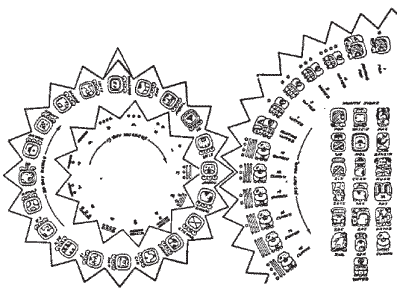
Figure 67
Searching for an answer, we find that when the linear fifty-year
time unit is meshed with the zodiacal cyclical unit of
seventy-two—the time that a shift of one degree requires—we arrive
at 3,600 (50 × 72 = 3,600), which was the (mathematical) orbital
period of Nibiru.
By linking a Jubilee calendar and the zodiacal calendar to Nibiru’s
orbit, was the biblical God saying,
“When you enter the Promised
Land, start the countdown to the Return”?
Some two thousand years ago, during a time of great messianic
fervor, it was recognized that the Jubilee was a divinely inspired
time unit for predicting the future—for calculating when the meshed
geared wheels of time will announce the Return. That recognition
underlies one of the most important post-biblical books, known as The
Book of Jubilees.
Though available now only from its Greek and later translations, it
was originally written in Hebrew, as fragments found among the
Dead
Sea scrolls confirm. Based on earlier extra-biblical treatises and
sacred traditions, it rewrote the Book of Genesis and part of Exodus
according to a calendar based on the Jubilee Time Unit.
It was a
product, all scholars agree, of messianic expectations at the time
when Rome occupied Jerusalem, and its purpose was to provide a means
by which to predict when the Messiah shall come—when the End of Days
shall occur.
It is the very task we have undertaken.
Back to Contents
|





